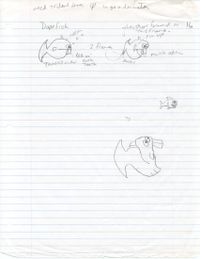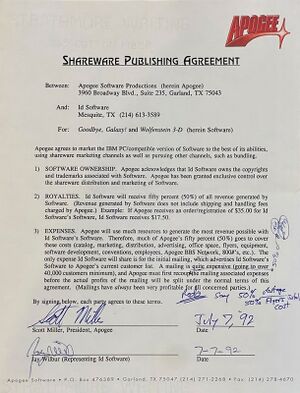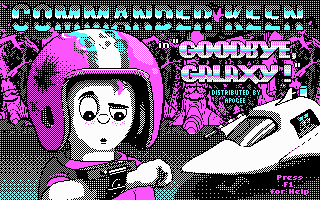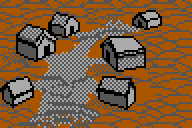Keen: Galaxy Development
This page is intended to have information regarding events that led to the development of Goodbye, Galaxy! and Aliens Ate My Baby Sitter! and some interesting insights into what happened during the development.
From dreams to galaxy
Creating a sequel to a success story
Creating a sequel that meets the hype generated by a successful predecessor is not an easy task, and neither was it that for the people over at id Software. Development of the true sequel started at around the same time Keen Dreams was finished, in June 1991, with the working title Commander Keen II: Goodbye, Galaxy!.
The original ambitions for the sequel included producing three separate versions of the game: a VGA, an EGA and a CGA version. Another improvement on the graphical side of things was to make the view slightly tilted instead of directly from the left. Plans for enhancing the sound experience included richer sound effects, addition of music and support for multiple sound cards (including Sound Blaster). The plans were to release the game by September 20, 1991 and it was planned to be another trilogy of episodes once again.
- * Commander Keen II: Goodbye Galaxy -- This game will break all records! There will be a 256-color VGA version, plus an EGA and a CGA version. All three versions will have multiple sound card support. This game will make the current Keen look like Pong─we have gone all out to make this the best game possible with many new innovations in graphics and animation. (Soon after the release off Goodbye Galaxy we will re-release the current Keen in CGA, EGA and 256-color VGA formats, with sound card support, too.) ─ Vendor letter from August, 1991
A shift in focus
It soon became apparent that the guys at id Software were a bit overly optimistic about how fast they would be able to finish the game. The new tilted graphics took a while bit longer to create than graphics created for the original trilogy took, and they needed considerably more graphics now than what they needed for Keen Dreams. Also for reasons unknown, the VGA version was soon dropped, perhaps because it wasn't seen as being worth the effort. Support for a Sound Blaster specific soundtrack was also dropped in favor of having just an Adlib soundtrack. Also, the tentative release date of the game was pushed back from September 20, 1991 to December 15, 1991.
id Software had also entered talks with FormGen Corporation, and FormGen managed to convince the guys that they should split the third episode into a separate title sold only at retail, and thus the direct sequel ended up consisting of only two episodes with the third episode getting a separate release.
The team moves to Madison, Wisconsin
Tom Hall, having grown up in Wisconsin, soon suggested that the team should relocate over to Madison. After the whole team took a trip over there during late summer, they agreed that it would make a much nicer neighborhood than their current one. So in September the whole team (except Jay Wilbur, who stayed behind because Softdisk needed him) moved over to Madison. Hall only forgot to mention how cold it could get there during winter, something the other guys who were born more down south weren't quite prepared for. Despite the cold weather they stayed there for the remainder of the development of the games.
Getting the titles out the door
Finishing the episodes
As logic would dictate, the guys at id Software wanted to finish off the fourth episode first to get the shareware release out there in order to promote the other two episodes. A preliminary five level demo version of Secret of the Oracle was released on October 9th, 1991 as part of a package FormGen Corporation put together promoting their upcoming games (it was used to promote Aliens Ate My Baby Sitter!). The episode wasn't quite finished yet as anyone who played the demo could tell, but things were definitely getting there.
- I had done most of the art in the original Keen trilogy. With Adrian working on this new set of Keen, his skills honed over many games, the art was looking awesome. ─ Tom Hall
- Deciding on the tilted perspective made things look really cool, but the levels took a lot longer to make. I think the overall art design was a lot cooler, though I have a definite place in my heart for the original Keen development. ─ Tom Hall
It would still take a month and a half before the finished version of Secret of the Oracle was released. In meantime, development of Aliens Ate My Baby Sitter! was starting to pick up and they both ended up getting finished at about the same time, with Secret of the Oracle getting its full release on November 22 and Aliens Ate My Baby Sitter! entering retail stores during very late November. A demo version of Aliens Ate My Baby Sitter! was also released, with three complete levels available for exploring.
The fifth episode, The Armageddon Machine, entered development in mid November. It was finished in a matter of just a single month but despite that it became the favorite episode of many, including Tom Hall. The second series ended up getting released in mid December under the title Commander Keen: Goodbye, Galaxy!.
- We did Keen 4, then Keen 6 (Aliens Ate My Baby Sitter), and then Keen 5. We did Keen 5 in one month. That was an amazing amount of work, but it's probably my favorite Keen, even though it doesn't have a Dopefish! ─ Tom Hall
The CGA versions
An interesting development in the sequel was the availability of CGA versions of each of the episodes. Ironically, the reason why id Software left Softdisk in the first place was the unavailability of their game(s) for CGA platforms. The problem with horizontal smooth scrolling wasn't quite overcome in the sequel either, but due to the significantly more detailed graphics, the jerkiness of the horizontal scrolling wasn't as noticeable.
The CGA versions were released simultaneously with the EGA versions of the games. In the case of Goodbye, Galaxy!, the CGA version was sold separately at a price $5 cheaper than that of the EGA version. For Aliens Ate My Baby Sitter!, both the EGA and CGA versions of the game was included in the retail package.
Despite it initially looking like there would be a market demand for these versions, the CGA specific version of Goodbye, Galaxy! sold very few copies and it was the reason no future Apogee Software games were released with CGA support.
- [Apogee Software] will not support CGA anymore. The CGA version of Goodbye Galaxy showed us that it's a dead market. ─ Scott Miller
Sales numbers
Despite having less bang for the buck with Goodbye, Galaxy! consisting of just two episodes, the initial sales of the sequel were just as good as that of the original trilogy. Tom Hall has expressed regret that they decided to split the third episode into a separate title, thinking that getting two episodes for payment instead of just one could have greatly increased sales.
- We got convinced to make the third game a commercial game, which I think hurt sales of the first two a lot. Getting a trilogy seems great. Getting the second half doesn't seem as cool. They still did decently, though. ─ Tom Hall
Post-release
Updating the game
Just like in the case of the original trilogy, there were also updates produced for the sequels. And similarly, these updates could only be obtained through purchasing new copies of the games since no good patching process had been invented yet. Sadly, The Armageddon Machine had a quite nasty bug in its original release where the secret level would always crash if you played it with the easy difficulty level. For a more specific list of changes made in the patches, see the respective pages for Keen 4, Keen 5 and Keen 6.
Publisher specific versions
There were also publisher specific versions of Goodbye, Galaxy! with at least FormGen Corporation and GT Interactive Software getting their own versions of the game. The version published by GT Interactive was a slightly newer version of the game.
The swastika
Hidden in a secret area of Energy Flow Systems, one can see a swastika in the piping layout. This was a reference to the upcoming title of id Software, Wolfenstein 3D. Later on this causes some unrest among gamers and so it ended up getting censored in the version released by GT Interactive at retail.
- Obviously, it was a reference to Wolfenstein... ? Sure, Keen 5 was created before Wolfy, but we knew that was our next project. ─ John Romero
Bio Menace
The engine used in the three episodes ended up getting reused in another Apogee Software game, Bio Menace.
Removed features
VGA version
As was already mentioned previously, a VGA version boasting 256 color graphics was initially planned to be released. The reason why the VGA version was scrapped quite early in development is unknown.
Sound Blaster soundtrack
A specific Sound Blaster soundtrack was planned for the game that could be enjoyed by gamers having a compatible sound card. Yet for reasons unknown, this also ended up getting dropped.
Desert town
There were plans to include a desert town in the game. Why exactly it ended up removed is not known, but since Keen 4 already has 18 levels, the most likely reason is that the developers felt that there already was more than plenty of levels available in the game.
The dort
Another creature was to be available in Secret of the Oracle, the Dort. The Dorts were apparently cow-like creatures that could be ridden, similarly to the Bounder. It eventually gave way for the Poison Slug. Possibly because its function was deemed too similar to that of the Bounder and it was therefore unnecessary.
A good old kick in the pants in Hillville
Ever wondered from where the title to this music track came from? Here's what Bobby Prince had to say on the matter:
- ...there is a level called 'Hillville,' and the first rendition of that level had little guys running around kicking everything in their path. I think these little guys bit the dust before the final release, but they were remembered in this song, as they inspired it. ─ Robert Prince
What these creatures were called and why they were removed is not known, however.
Unused music in The Armageddon Machine
There's an unused piece of music in The Armageddon Machine. It probably ended up being unused simply because the amount of levels available in the episode is relatively small.
Trident power

It seems that originally you were not supposed to find the Wetsuit in order to be able to swim in Secret of the Oracle. There's a mention of trident power being necessary to be able to go underwater in one of the design notes by Tom Hall. Perhaps such a power was seen as being too mythological and was therefore replaced?
Alternate Hillville
If you ever looked at the world map icon of Hillville, you have no doubt noticed that there are a bunch of houses visible. Yet those with a keen eye for detail have no doubt also noticed that there are actually no houses in the level itself. The level data indicates that there have indeed been houses in this level at some point in development, but that they were removed in favor of hills.
Lifewater Oasis
Probably everyone who has played this level more than once has noticed that there are inaccessible scores at the bottom of the level. This is a result of a redesign of the level that occurred during development. The fact that these scores were unreachable after the redesign wasn't noticed by the developers before the game was released.
Gallery
References
- id Software (1996). The Book of id. Mesquite, Texas.
- A Look Back at Commander Keen



